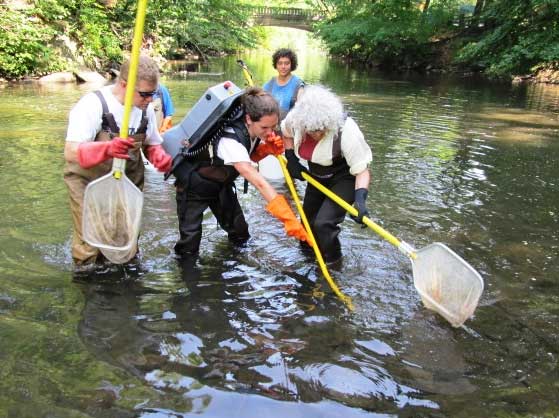Some Other Recent Projects
Conservation of Jamaica Bay
Jamaica Bay–home of the only U.S. National Park one can reach by subway–is environmentally stressed in multitudinous way but it’s also a resilient, functioning ecosystem with many admirers. In 2011 I had a conversation with the head of the National Parks of New York Harbor Conservancy about the existing Jamaica Bay Institute that led to Interior Secretary Ken Salazar and Mayor Michael Bloomberg soon announcing plans for a Jamaica Bay ecology center. With colleagues I helped develop a proposal and a team of external partners that was awarded the contract to develop what is now being called the Jamaica Bay Science & Resilience Center. Work continues to move towards a CUNY-led institution with an assemblage of strong technical and educational partners that will increase our knowledge of Jamaica Bay and also use it as a model for increasing environmental resilience in an urban estuary, a goal with its importance only magnified by Superstorm Sandy.

There are many studies that can and should be done Jamaica Bay. In 2008 I prepared a Research Opportunities Report for the National Park Service. In September 2007, a colleague and I organized a 24-hour Bioblitz at the Bay in which 273 volunteers discovered nearly 700 plant and animal species. I also worked with a small team from the New York City Department of Environmental Protection and others to look at possibilities for creating salinity gradients in at least one creek leading to Jamaica Bay. Though modeling showed only modest possible effects from available water sources, opportunities may exist to add water to upland areas that would create lotic habitats before entering a tidal creek. In 2018 colleague William Solecki of Hunter College and I prepared a report titled The Great Transformation: Exploring Jamaica Bay in the Late 19th and Early 20th Centuries Through Newspaper Accounts. This report, which makes unique use of archived newspapers will be revised as a book. (Photo is of sorting beach seine catch at the Bioblitz).
Stock Identification & Population Genetics of Fishes
Stock identification is a fascinating crossroads among the evolution, ecology, and management of fishes. I have collaborated with Isaac Wirgin of NYU’s Langone Medical Center since we met in the CUNY doctoral program, coauthoring more than 50 papers on the stock identification, population genetics, and conservation biology of (mostly) Atlantic anadromous fishes. These include American shad, striped bass, Atlantic sturgeon, shortnose sturgeon, summer flounder, monkfish, and even a fish eating mammal–the mink. (In photo Wirgin is gingerly lifting a decayed sea lamprey from the Delaware River to obtain tissue for DNA analysis). I’ve also collaborated with colleagues on New York region environmental DNA research on fishes including on the effects of dam on eels in an urban river.

Environment & Fishes of Mongolia
Mongolia is twice the size of Texas, yet is has only the population of Brooklyn–and half of this number lives in the capital city, Ulan Bator. Mongolia is also experiencing some of the most profound climate changes in the world and is undergoing a rapid expansion of environmentally harmful mining. Mongolia also is home to the taimen, a large, primitive salmonid of both high angling and conservation interest–taimen apex predators that reach 100 pounds and are known to take rodents and ducks off the water surface. And in the nation’s northwest, near Siberia, sits one of the world’s oldest and most biologically unique lakes, Hovsgol. I’ve been to Mongolia three times, the second on a lengthy expedition to the Eg – Uur River system and to Lake Hovsgol to collect specimens of taimen and other fishes, as part of a Mongolian-American aquatic ecology research initiative. Colleagues and I used DNA to estimate times of recolonization of Hovsgol by a suite of fishes following deglaciation.
Bronx River Restoration
New York City contains one true river and it bisects the Bronx Peninsula. Interest in restoring the Bronx River has grown enormously, led by the Bronx River Alliance, made up of dozens of partners. Colleagues and I have been surveying and monitoring the Bronx River for usage by eels and alewives as part of a study on improving the river as habitat for diadromous fishes. We have found that although some eels make it past the first several dams in the system, each appears to reduce penetration upriver.
